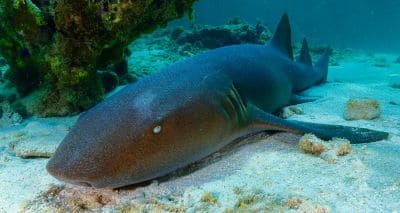Home › Ocean Life › Marine › Vertebrates › Sharks › Nurse Shark
Nurse Shark Facts and Information
[Phylum: Chordata] [Class: Chondrichthyes] [Order: Orectolobiformes] [Family: Ginglymostomatidae]
Despite being generally harmless to humans, one of the large bottom-dwelling predatory sharks has a wide curved mouth and makes a sucking sound when it searches for food in the sand.
This segment contains fun and interesting facts about nurse sharks (Ginglymostoma cirratum), including what they eat, where they live, and how they reproduce.
Where Do Nurse Sharks Live in the Oceans
The far-reaching geographical distribution of the nurse shark stretches to most tropical and subtropical warm water coastal areas, especially:
- Eastern Atlantic (e.g. Cape Verde)
- Southern Brazil
- Eastern Pacific (Baja California, Peru)
- Western Atlantic (e.g. Rhode Island, Caribbean)
For the most part, they spend most of their time resting on the ocean floor in shallow ecosystems, such as inshore reefs and mangroves.
As the juveniles develop and grow into adults, the older specimens tend to shift location. In later life, nurse sharks spend more time living around much deeper rocky outcrops and coral reefs.
You'll need to have keen eyes to spot them hiding underneath submerged ledges and crevices during the daylight, often sleeping together in groups of ten or more and piled on top of each other.
Nurse sharks are most active at night. As the darkness arrives, these mostly solitary hunters scavenge the sea bed rummaging around trying to find their favourite source of food, sea snails and marine crustaceans.
Nurse Shark Behaviour and Characteristics
Ginglymostoma cirratum are slow-moving bottom-dwellers. The first and second dorsal fins are rounded, and they have two large, curved pectoral fins.
Other distinguishing features of the nurse shark are the elongated caudal fin and a wide, almost flattened, blunted head.
Here's the thing:
Official documentation about the maximum length and weight of nurse sharks is "patchy". But, specimens that can grow over three metres long (10 feet), and weigh up to 140 kilograms (300 pounds), seem commonplace in many areas around the world.
When they become adults, nurse sharks display a brownish grey body colouring. Unlike almost all other species of sharks, the skin of the nurse shark is smooth.
Scuba divers beware!
In fact, there are about thirty shark species that attack humans, including the requiem sharks. By and large, nurse sharks are docile, human-friendly fishes that eat small animals. Even so, they will bite in defence and documented cases of nurse sharks biting humans do exist!
Pro Tip: There are around forty (4) different carpet shark species. Some of them, such as G. cirratum, can suffer from piebaldism that often produces a speckled skin tone in fish.
What Do Nurse Sharks Eat?
These typical carnivores use their strong jaws and rows of fine, saw-edged teeth to crush and mangle shelled prey, especially snails. But, they can also suck up a variety of marine invertebrates from the ocean floor, such as:
- Coral reef polyps
 Cuttlefish
Cuttlefish- Lobster
- Mollusca
- Shellfish (e.g. clams, scallops)
- Shrimp
- Small, slow-moving fish
- Squid cephalopods
- Stingrays
- Tunicates (e.g. sea squirts)
Pro Tip: The index sections contain many more examples of vertebrates fish with extra information about how the different types of marine invertebrates influence the food chain in aquatic environments.
How Do Nurse Sharks Reproduce?
The nurse shark mating cycle occurs bienally (it happens one time every two years) and usually in July when the water gets warmer.
Despite engaging in multiple paternity, the females need to wait about eighteen months before they can produce a new batch of eggs.
The gestation period of a female nurse shark is six (6) months and an average litter size is 25 pups. But, because they are ovoviviparous, fertilised eggs hatch inside the parent's body.
Juveniles leave the mother fully developed when they are born. When they emerge nascent, they will have spotted skin colouring and already be about thirty (30) centimetres long (almost 12 inches).
Threats and Predators
Nurse sharks are robust fish, and they will tolerate capture and man-handling. For this reason, they have become an important part of several shark research and conservation projects.
By and large, they are calm creatures and their sedentary lifestyle could be one reason why they have an average lifespan around 25 years.
Nonetheless, many of the nurse shark species are classified as threatened or in a vulnerable status, mostly due to bycatch and overfishing.
- Atlantic nurse shark (Vulnerable)
- Pacific nurse shark (Endangered)
- Sand tiger shark (Critically Endangered)
- Short-tail nurse shark (Critically Endangered)
- Smalltooth sandtiger (Vulnerable)
- Tawny nurse shark (Vulnerable)
Important: The IUCN Red List of Threatened Species is a comprehensive source of information about the global conservation status of animals, fungi, and plants.
Related Information and Help Guides
- Interesting Facts about Angel Sharks (Squatina Squatina)
- Blue Shark Fun Facts and Interesting Information with Photos
- Bull Shark Breeding Season and Life Cycle
- Planned Release of Baby Sharks in Thailand (Pattaya)
- Horn Shark (Heterodontus Francisci) Fun Facts and Information
- Leopard Shark Behaviour and Unusual Characteristics
- Whitetip Reef Shark Interesting Facts and Information with Images
Note: The short video [2:35 seconds] presented by "Deep Marine Scenes" contains footage of the sluggish, bottom-dwelling nurse shark swimming in its natural habitat.